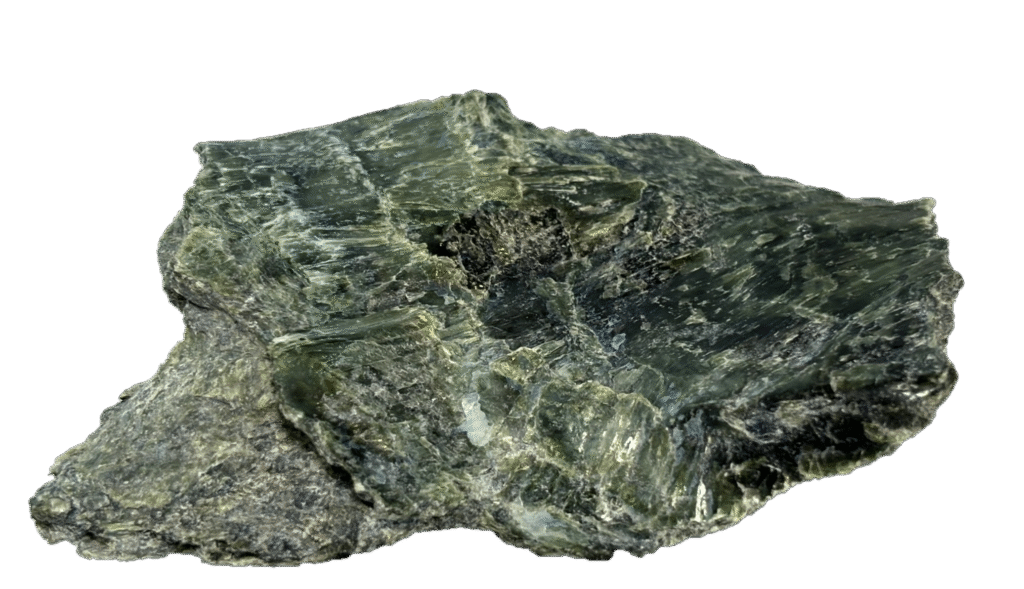
Serpentine, a gemstone admired for its rich green hues and ancient associations, has long been cherished for its aesthetic appeal, metaphysical properties, and connection to nature. This comprehensive article delves into the stone’s origins, characteristics, and its profound significance across cultures and history.
Origins of Its Name and Alternate Names
The name “Serpentine” is derived from the Latin word serpens, meaning “serpent.” This name reflects the stone’s characteristic green and scaly appearance, reminiscent of snake skin. Throughout history, serpents have been symbols of transformation, healing, and renewal, which aligns with the stone’s spiritual significance.
Alternate names for Serpentine include “New Jade,” a term used in the gemstone market to highlight its visual similarity to the more valuable jade. Higher-quality varieties are sometimes referred to as “Noble Serpentine” for their lustrous, refined finish.
Composition and Physical Characteristics
Serpentine is not a single mineral but rather a group of related minerals, primarily composed of magnesium silicate. Its formation occurs through the metamorphism of ultramafic rocks, resulting in distinctive patterns and textures.
Physical Characteristics and Varieties
- Appearance: Typically green, ranging from light lime to dark olive, often with marbled or mottled patterns. Some specimens may include flecks of black or white.
- Hardness: Measures 2.5 to 5.5 on the Mohs scale, making it softer than many other gemstones.
- Lustre: Can range from waxy and dull to silky and glossy, depending on the variety and polishing.
Common varieties of Serpentine include:
- Antigorite: Known for its fibrous texture and lustrous appearance.
- Bowenite: A denser, jade-like form often used in carvings and ornaments.
- Williamsite: A translucent green variety prized in jewellery.
Geographical Locations
Serpentine can be found in many parts of the world, particularly in regions with active geological processes. Key locations include:
- Italy: Especially abundant in the Apennine Mountains, where it has been used historically in art and architecture.
- United Kingdom: Found in Cornwall and the Lizard Peninsula, which is known for its serpentinised peridotite deposits.
- China: Produces high-quality specimens often used in carvings.
- United States: Particularly in California and Vermont, where it is considered the state rock.
- New Zealand: Home to Bowenite, a variety highly valued by Māori artisans.
Historical Usage and Archaeological Finds
Serpentine has been used by various civilisations for thousands of years. Its smooth texture and vibrant colour made it a popular material for tools, jewellery, and ceremonial objects in ancient times.
- Ancient Egypt: Serpentine was carved into protective amulets and small statues, symbolising renewal and protection.
- China: Valued for its jade-like appearance, it has been used in art and ornamentation for centuries.
- Indigenous Cultures: Māori artisans in New Zealand crafted tools and jewellery from Bowenite, attributing spiritual significance to the stone.
Today, Serpentine continues to be used in jewellery, home décor, and holistic healing practices.
Interesting Facts
- Serpentine is one of the oldest stones used by humans, with archaeological evidence of its use dating back over 6,000 years.
- It has been associated with protection against toxins, due to its connection with serpents and their symbolism in many cultures.
- Some varieties of Serpentine contain trace amounts of asbestos, which is important to note when handling raw specimens.
Folklore, Superstition, Legends, and Tales
Serpentine has a long association with myths and legends, particularly those involving snakes and transformation. Its name alone conjures images of serpents, which are often symbolic of rebirth and wisdom in various cultures.
In ancient Greek mythology, Serpentine was believed to carry the energy of Asklepios, the god of healing. It was often used as a talisman to protect against snake bites and other toxins. This belief extended into Roman times, where it was thought to provide both physical and spiritual protection.
In Celtic traditions, Serpentine was regarded as a sacred stone, tied to the Earth and water elements. Druids used it in rituals to connect with natural forces and to seek guidance during transformative periods.
Some Native American tribes revered Serpentine as a “Guardian Stone.” Its smooth green surface was seen as a representation of harmony and balance, aligning with the cycles of nature. The stone was believed to carry the wisdom of the Earth, offering insight and clarity to those who worked with it.
In metaphysical lore, Serpentine is often referred to as a “Stone of Awakening.” It is said to activate the kundalini energy believed to lie dormant at the base of the spine, facilitating spiritual growth and personal transformation.
Mystical Healing Properties
Serpentine is valued in holistic healing for its perceived ability to ground energy and facilitate personal growth:
- Emotional Healing: Encourages emotional balance, resilience, and self-confidence.
- Physical Healing: Believed to detoxify the body, aid in calcium and magnesium absorption, and support overall vitality.
- Spiritual Healing: Promotes spiritual awakening, enhances meditation, and fosters a deep connection to the Earth’s energy.
Astrological Links and the Chakra System
Serpentine resonates with the Heart Chakra, helping to balance emotions and nurture compassion. It also aligns with the Crown Chakra, fostering spiritual enlightenment and higher consciousness.
Astrologically, Serpentine is associated with Gemini and Scorpio. Its transformative energy complements Gemini’s adaptability and Scorpio’s focus on growth and renewal.
Use as a Birthstone and Wedding Anniversary Gift
While not an official birthstone, Serpentine is often chosen for its symbolic links to transformation and renewal, making it a thoughtful gift for those undergoing life changes.
As a wedding anniversary gift, Serpentine represents the enduring qualities of love and growth, making it particularly meaningful for milestones that celebrate renewal in a relationship.

Serpentine
Serpentine awakens ancient wisdom and renewal, aiding detox, emotional healing, and kundalini flow. A transformative stone of growth, balance, and protection.
